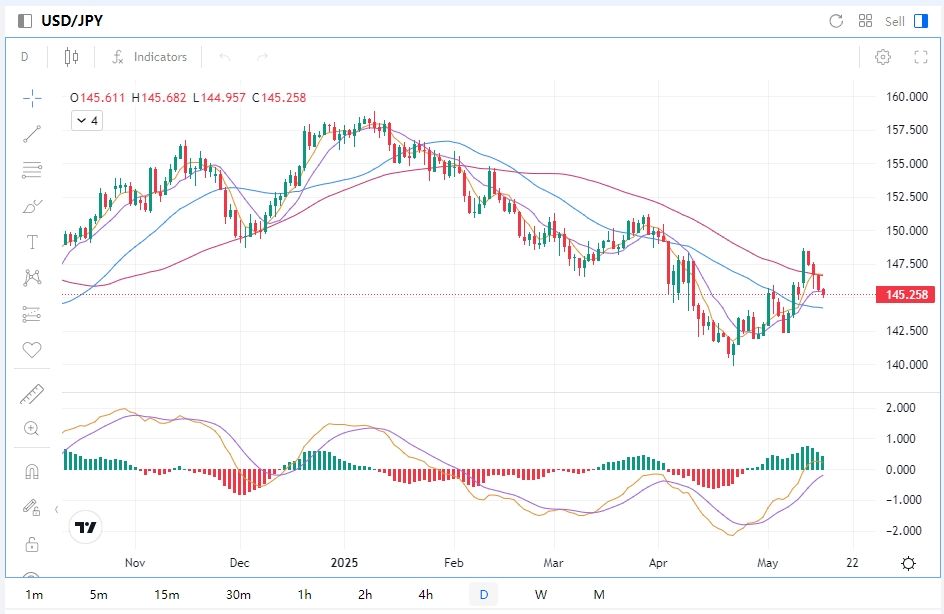Japan's economy has fallen back to negative growth after one year. Will yen continue to weaken?
TradingKey - Japan's economic performance is lackluster, with the preliminary annualized quarterly GDP for the first quarter recorded at -0.7%. This marks the first contraction in a year, and the economy may face further impacts from Trump’s tariffs. The weaknesses in Japan's economy have become apparent, and a technical recession has already occurred. After three consecutive weeks of decline, the Japanese yen exchange rate has begun to stabilize this week. The USD/JPY surged before pulling back, facing strong selling pressure at higher levels. However, the upward rebound may continue, with resistance at 148.50.
On May 16, the Cabinet Office of Japan announced preliminary statistics indicating that Japan's seasonally adjusted real GDP for the first quarter of 2025 decreased by 0.2% on a quarter-on-quarter basis and dropped 0.7% on an annualized rate. The data showed that in the first quarter, personal consumption, which accounts for more than half of Japan's economy, recorded nearly zero growth. The Cabinet Office pointed out that the main reasons for the negative economic growth in that quarter were the sluggish personal consumption and external demand. This marks the second time in a year that Japan's economy has experienced negative growth.
Krishna Bhimavarapu, a strategist at State Street Global Advisors, stated that these figures put pressure on optimistic sentiment as Japan prepares to deal with the impact of tariffs. However, he mentioned, "We expect a reasonable agreement will be reached with the U.S. in the coming months, which should alleviate the impacts."
Since the first-quarter GDP data was recorded before the implementation of Trump's tariffs, the Japanese economy may continue to be suppressed after the tariffs are imposed. Due to the tariffs, major Japanese companies have begun to lower their profit forecasts, with Toyota predicting a roughly one-third drop in profits for the current fiscal year.
Yasuyuki Shinkai, a senior economist at Dai-ichi Life Research Institute, remarked that Japan's economy currently lacks growth engines, and this was the case even before the impact of Trump's tariffs. There is a high likelihood of consecutive contraction over the next two quarters.
Due to the uncertainties surrounding Trump's tariff policies, investor concerns about the U.S. economy have intensified, leading to a significant outflow of U.S. capital into Japan's financial markets. Data released by Japan's Ministry of Finance on the 12th showed that in April, overseas investors purchased Japanese stocks and bonds worth over 8 trillion yen (approximately 54 billion USD). This is the highest level recorded since comparable data became available in 2005.
Daisuke Uno, chief strategist at Sumitomo Mitsui Banking Corporation, noted that as market expectations for a Bank of Japan interest rate hike gradually wane, the strategy of buying the yen will be difficult to sustain.
U.S. retail sales growth slowed in April, revealing signs of fatigue in consumer spending. Data released by the U.S. Department of Commerce on Thursday showed that the month-on-month growth rate for U.S. retail sales plummeted to 0.1%, down from a revised previous value of 1.7%, albeit still above the expected flat growth. The weak economic performance has raised investors' expectations for a Federal Reserve interest rate cut.
Federal Reserve Chair Jerome Powell indicated that inflation might become more volatile in the future, suggesting that the U.S. may be entering a period of more frequent and longer-lasting supply shocks, which presents a significant challenge for both the economy and the central bank.
Technical Analysis of USD/JPY

Source: Mitrade USD/JPY Trends
On the technical front, after three consecutive weeks of rising, the USD/JPY experienced a pullback this week, with increased selling pressure at higher levels. On the daily chart, the USD/JPY remains within a downward channel, but the 5-day and 10-day moving averages have turned upwards, which may provide some support for the exchange rate. The KD indicator shows both lines remain above 50 but are moving downward, indicating strong bearish momentum in the market. The overall upward rebound pattern for USD/JPY may continue, with initial resistance at the 148.50 level.
The initial resistance level for USD/JPY on the upside is at 148.50, with further resistance at 152.00 and a key resistance level at 154.00. For the downside, the initial support level for USD/JPY is at 142.50, with further support at 140.50, and a key support level at 139.00.



